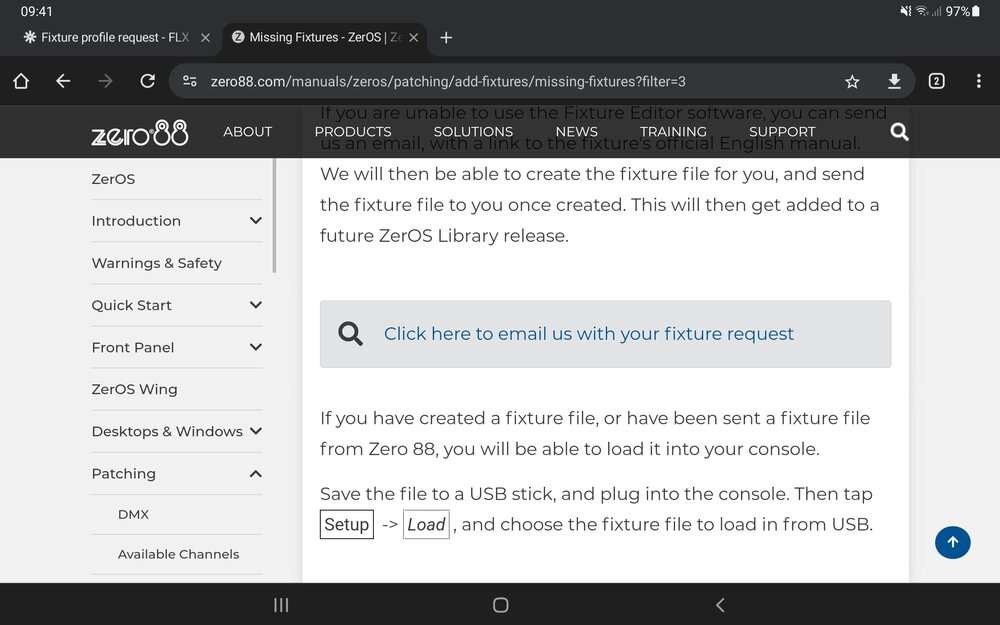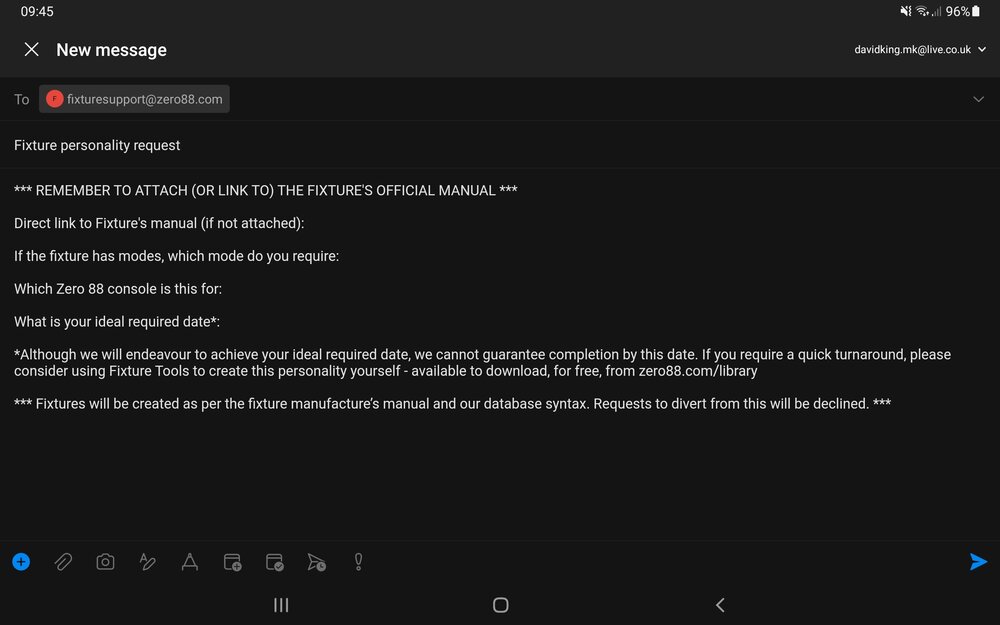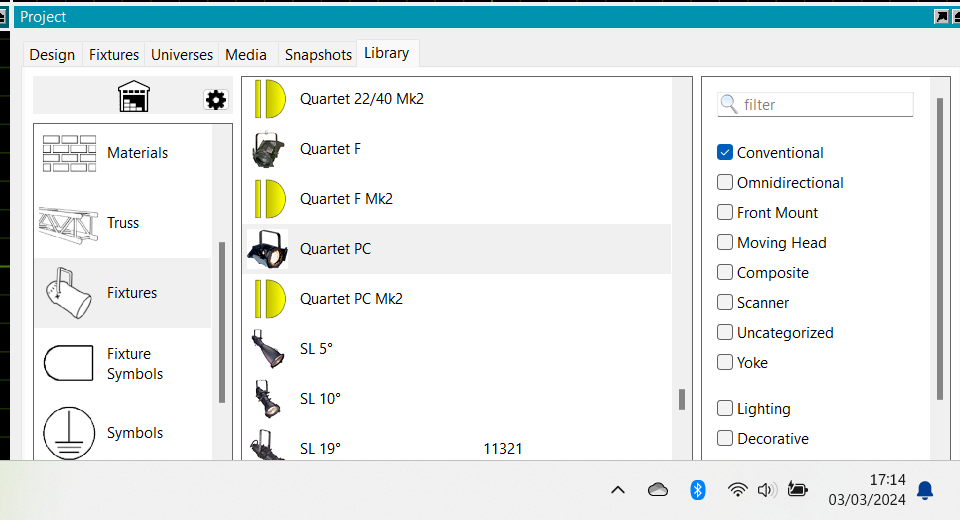
Davidmk
Regulars-
Posts
395 -
Joined
-
Last visited
-
Days Won
32
Everything posted by Davidmk
-
Thanks Jon. You should get an auto acknowledge on that mail box. Save exchanges like this 😁
-
I mailed support@zero88.com on Sunday and I've heard nothing. Not even an auto acknowledgement. Is it still valid?
-
@Jon Hole Is there anywhere outside London? Not only do I hate driving there I'm going to get hit with extra charges.
-
Where is the nearest place to Milton Keynes where I can get an FLX serviced/repaired? (I have a fader that only goes up to 97% that hasn't been fixed using Servisol.)
-
@kgallen I'm guilty of this too, there's a clash of terminology - I try to say "DMX channel" when I mean that and leave an unqualifed "channel" to mean desk channel.
-
I thought that which was why I went to the specs to check. They also say 2x5pin XLR so perhaps they've slipped into an alternate reality. 😁
-
From the online specs for S24... Cost effective 24 fader console with support for 1024 channels of control And... 2 x 5-Pin DMX ports... So you should already have two universes worth of DMX channels and only need to make sure they are setup two output to the two DMX outputs on the back of the desk (or to the ArtNet equivalent). Check the manual here. As @kgallen says, the available channels and fixtures on FLX Sxx will be doubled anyway when Zeros v8.0.0 is released. This is in Beta test at the moment so it shouldn't be too long before it is released. The release notes for v8 state... All FLX S24 & FLX S48 consoles have been upgraded to 2048 channels ("four universes") free of charge. All full size FLX consoles & ZerOS Servers have been upgraded to 4096 channels ("eight universes") free of charge. (FLX consoles and ZerOS Servers which are licenced for more than 4096 channels will retain their higher licence). Note that FLX desks are restricted by channels, not universes so, if you have enough channels for your fixtures but want a second universe for convenience then all you need to do is go into setup and assign universe 2 to the 2nd DMX output or to ArtNet if you have that.
-
FLX S24 CLEAR LED stubbornly stays lit (7.14)
Davidmk replied to kgallen's topic in FLX S24 & FLX S48
I was going to do that for an AmDram but their S48 was not up to date and couldn't run the showfile so I was going to lend them my FLX The nominated op pulled out last minute because, they said, they wouldn't know how to operate manually if anything went wrong. So I had to run the show myself. -
FLX S24 CLEAR LED stubbornly stays lit (7.14)
Davidmk replied to kgallen's topic in FLX S24 & FLX S48
Wishing you well on your adventure! -
FLX S24 CLEAR LED stubbornly stays lit (7.14)
Davidmk replied to kgallen's topic in FLX S24 & FLX S48
Manual says "hold setup and tap the pallette" to name them. Hopefully that same trick applies to naming other things. Doing a play for an AmDram I was confronted with an S48. I unplugged it and plugged in my FLX so I'm no wiser than you really. Or rather I know less than you since you've already learnt something about Sxx. -
FLX S24 CLEAR LED stubbornly stays lit (7.14)
Davidmk replied to kgallen's topic in FLX S24 & FLX S48
Just a guess but does the clear light stay on while a programmer time fade is going on? (And, is the programmer time set at 10s?) -
ZerOS 7.14.3 Released and ZerOS 7.15 Coming Soon!
Davidmk replied to Jon Hole's topic in News & Announcements
I was at PLASA on Monday. I went hoping there'd be a Z88 announcement to discuss (a replacement for the FLX for example). Previously I'd have stopped for a chat anyway but, although VariLite weren't busy, I didn't have time after waiting to talk to Chamsys, Infinity, Vista and Lightshark about their offerings in my price bracket. Did linger over the Sirius in the "archaeology" display though. 😊 -
I'm a limited ArtNet/sACN user but, as this has partly become a Thomann discussion here's my take on it. I concur with what's been said about Thomann and some of their own-brand products. Not as pleased with Stairville as I am with Varytec for example. The only drawback with ordering from Germany is that orders can vanish into UK customs for an indeterminate time and, with Thomann, you don't get proper tracking until they come out. Customs checks are a product of Brexit of course but place your order well before you need the gear as it might take longer than expected. As to this particular product, I suggest you read the reviews and consider whether you might want sACN now or in the future. (I actually use these which are dead easy to set up but, sadly, they appear to have been discontinued. Don't think they supported RDM anyway. I've got one of these as well. Only 2 universe, not RDM but just as easy to use as the 4 universe node. Might still be available although not from Thomann)
-
A quick Google for "midi to osc converter" shows a lot of people have had the same issue in various situations and some of the hits cover solutions that are on offer. These include free options. I haven't time to review any of the options and, even if I did you should still carry out your own research but I am intrigued by the first result I got. ShowCockpit, it costs between €30 and .€299 depending on on the options you want and seems to be well documented. This is not a reccomendation but it interested me enough that I may give it a try myself even though I already use a TouchOSC thing I wrote which includes midi input and OSC output. In 24 years I've had one touring show come in that wanted midi control of the desk and it might be handy to have a solution on standby in case it happens again. Looking at free options I found MidiMonster interesting. It is open source and appears to be free. It's a bit more complicated to set up but not too bad and there is documentation although it seems a bit sketchy. Again, you should do your own research - there could be better options. When you get a solution that works you should give the forum a heads up as there may be others that need it.
-
You can do it with TouchOSC (the new, paid version not the mk1, free one) but it would require some coding.
-
If this means exactly match then that might be the problem. The first 3 numbers of the laptop's address should match, the last should be between 0 (or is it 1) and 255 but different to any of the addresses used by the desk. Note that the desk should have a number of addresses, at least one for the desk itself then, if you are using them, one each for ArtNet/sACN, CITP, remote apps, tracking backup and OSC,
-
This might be helpful as well... https://www.zero88.com/manuals/zeros/patching/add-fixtures/edit-export
-
That's odd because it takes me to this page of the manual. Near the bottom of that page there's a link (see 1st attachment) and that opens a new mail in my maill app (outlook - see 2nd attachment). This is on Android.
-
I think you'll find cue 1 has always had a zero time but you've never noticed it. The manual says... Cue 1, will always have a 0 second fade up and fade down time for intensity. This is to ensure that the intensity follows the level of the playback fader. Check here for more information. (Incidentally, when @Edward Z88 checks the forum he'll likely move your post to the FLX S thread.)
-
I think it's selecting the fixture button that spoils it so it should be... press record then the ‘home’ symbol and select default No doubt @Edward Z88 will be along in the morning to confirm or correct this.
-
ZerOS 7.14.3 Released and ZerOS 7.15 Coming Soon!
Davidmk replied to Jon Hole's topic in News & Announcements
ZerOS 7.15 mettra à niveau toutes les consoles FLX S24 et FLX S48 vers 2048 canaux (quatre univers) et 96 et 192 appareils respectivement gratuitement. Les lectures, groupes et palettes disponibles seront également doublés. -
@kgallen has said it all really. You will be missed by the user community and, I'm sure, by your colleagues. Wishing you the best in your future endeavours. Every confidence in @Edward Z88 and @Jon Hole but this is still a pity.
-
@kgallen It's HTP that's the issue. As you say an inhibit taken to zero would take them out but you have to take it down to do it and I don't think the macro could replicate taking a fader to zero, besides you'd need it to go back up again on releasing the UDK. Am I right in thinking that PB settings include intensity as LTP? If so, would a PB with those fixtures at zero with LTP intensity and release on lower do the trick? (Not an inhibit or they'll never come on). Leave the fader alone and use the flash button. Not sure this would work either and don't have time to try it out or check the manual.
-
Well, I've just downloaded and installed the latest update to Capture 2023 (for which I am licensed) and the Quartet PC is there... But, if you are using the student edition then I expect you have read the limitations - if not then they say... Capture 2023 Student Edition The Student Edition of Capture is a free version of Capture that may be used for any purpose, educational or not. Feature-wise it is based on the Solo Edition, with the following differences: Unlimited number of DMX universes. Reduced amount of trusses and fixtures in the library. The full list of fixtures is available here. Motion (DMX movers, DMX rotators and motion constructs) and effects (CO2, fire and water jets) are not available. Opens and saves Student Edition project files only. Does not export Capture Presentation files. All console connectivity options except MA-Net3 are present and fully functional. and will have checked out the link to available fixtures which, sadly, does not include your specific models. Are you a student at an establishment which has an education licence for Capture? If so then speak to your tutor as they may be able to help. If no then, for the purposes of trying out effects and seeing roughly how your programming will look then you will need to use the closest available fixtures from the reduced set available in the student edition. Free editions of software will always have some limitations - nobody would pay for a licence if they didn't - and Capture student appears to have what you need to set students a design task and for them to complete the assignment.
-
I can't check this because I have a Capture licence but I don't think you can do much without a licence except load the dockhouse file and use it as it stands. Obviously you need to load the dockhouse show file into your desk or phantom ZerOS as well.




